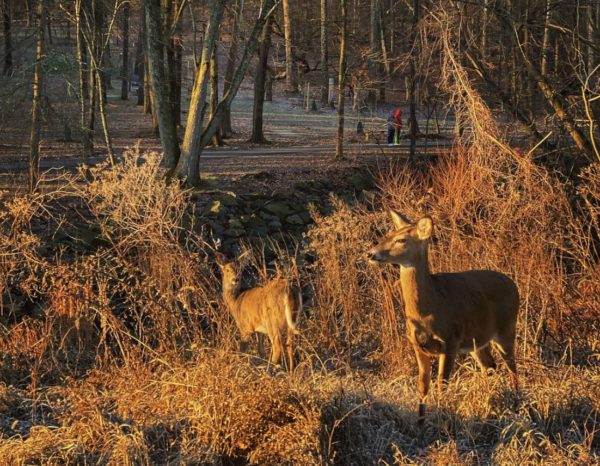
The Animal Welfare League of Arlington is bucking the results of a study suggesting the county has a deer problem.
Arlington County hired a consultant last spring to count the local deer population using drones. The company published a report in September saying that parts of Arlington had populations of 20-39 deer per square mile in certain places, exceeding what’s considered healthy (between 5 and 15 deer per square mile).
In a statement released Monday, AWLA, which oversees animal control for Arlington County, disputed the idea that the local deer population reaches unhealthy levels and urged the county to adopt a “practical, humane, and sustainable deer management plan” that doesn’t place too much focus on the numbers.
“From our extensive work in humane wildlife management, we know from experience that the issue is not the number of deer but rather the conflicts we have with them,” AWLA President & CEO Samuel Wolbert and Chief of Animal Control Jennifer Toussaint said.
The joint statement comes as county staff prepare to incorporate this data into a broader look at what steps Arlington needs to take, if any, to maintain a healthy white-tailed deer population.
Wolbert and Toussaint say there’s “scientific basis” for the claim that 5-15 deer per square mile is healthy, arguing no single count of deer qualifies as over-population.
“The fact is, determining a ‘healthy carrying capacity’ is a political judgement that is not rooted in biology: some communities, and even areas within a community, will be able to sustain different numbers of deer based on multiple factors, like type and quality of food and cover,” they said. “There is no one ‘magic’ number that any community should have. Saying Arlington County, with 13 deer per square mile, has too many deer is a political determination and not based on the environment in which the deer are located.”
AWLA leaders say complaints about deer may have precipitated this survey, but of all the calls and online reports their animal control division receives related to wildlife, relatively few involve deer.
Since November 2020, when it launched an online reporting system, AWLA has received over 650 wildlife concerns, and of those, 17 (3%) related to deer. Meanwhile, in 2021, 131 calls of the 2,733 calls for service related to wildlife (or 5%) were deer-related — and the most common concern was about the health of orphaned fawns.
“If there truly were ‘too many deer’ we, as the County’s wildlife experts, would have more deer-related complaints or issues arising from deer — which is simply not the case,” Wolbert and Toussaint said.
As for the argument that deer contribute to the destruction of the forest understory, cited in the report, AWLA leaders argue that deers are unfairly blamed for the impacts of other factors.
“It’s easy to blame deer for any forestry growth woes, when the reality is that forests are affected by many factors: insect damage, disease, pollutants (like harsh fertilizers), invasive species, increased foot traffic, climate and weather extremes, over-development… and deer,” Wolbert and Toussaint write.
In response, Arlington County Department of Parks and Recreation said the survey was just the first step in determining whether Arlington needs to more actively manage deer. Next, the county will hire a professional wildlife consultant to interpret this data and gather additional information to determine if and how deer are impacting the natural landscape, said DPR spokeswoman Susan Kalish.
All this information will guide a public engagement process that will culminate with a presentation to the County Board this summer.
“Deer are necessary aspects of wildlife with important ecological functions when in balance with the surrounding habitat,” Kalish said. “Arlington takes its role as a steward of wildlife and its natural lands seriously.”
Arlington County recently funded a deer survey to establish a count of our white-tailed deer population. The results of this survey suggest that Arlington County has a “deer problem”…but we disagree. Read our President & Chief ACO's statement here: https://t.co/eFH9tuSHOc pic.twitter.com/0F4W3i7SL1
— AWLArlington, VA (@AWLAArlington) February 7, 2022

